
La Earthcache / The Earthcache
L'église de Saint Martin de la Selle Craonnaise présente pour sa construction deux roches locales permettant d'en faire une étude comparée.
► Les "Roussards"
Les "Roussards" sont un ensemble de formation sédimentaire d'origine détritique. En tant que telle, leur nature lithologique dépend de la taille de ses sédiments (classification granulométrique).
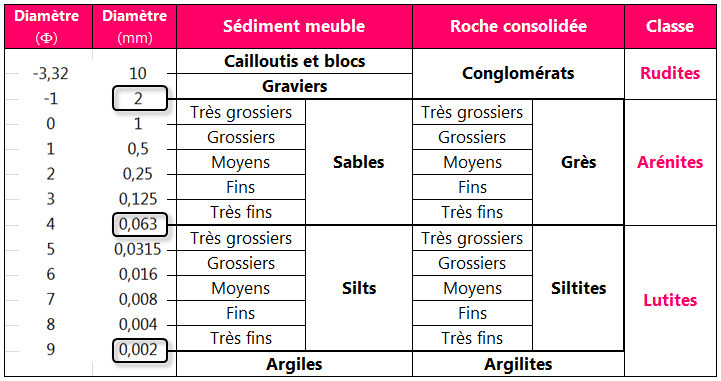
Une roche "Roussard" se distinguent des autres formations détritiques par son ciment ferrugineux.
Sous un climat chaud et humide, les eaux enrichies en silice et fer cimentent les clastes en une cuirasse ferrugineuse, donnant une matrice de couleur brun profond à rouille, très dure.
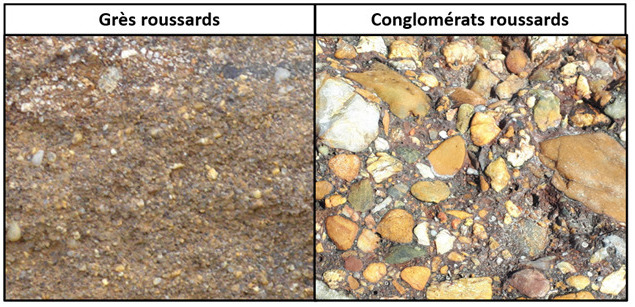
► Le granite, une roche QFM
Le granite est une formation cristalline plutôt claire, homogène, dure, non litée, provenant de la cristallisation en profondeur d'un magma.
Sa composition chimique majoritaire est de 3 minéraux aux initiales "QFM" :
- Q comme Quartz : translucide parfois transparent, ce minéral est de couleur gris sans facette.
- F comme Feldspath : blanchâtre ou rose, ce minéral est opaque et souvent en macles.
- M comme Mica : noir ou blanc, ce minéral se présente en fines lamelles brillantes.
La roche a une texture grenue dont la taille des grains est directement liée à la vitesse de cristallisation : plus les cristaux sont gros, plus la vitesse de cristallisation est lente.
Dans le cas extrême, les plus gros cristaux de feldspaths dépassent un centimètre de long et sont appelés des phénocristaux.
On parle alors de granite à texture porphyroïde.

Le granite contient parfois des enclaves appelées des autolithes.
Ces autolithes ont la même origine que son encaissant et sont le résultat de deux phases distinctes dans la formation du granite dues à des conditions particulières (baisse très progressive de la température) et une composition chimique originale (teneur importante en ferromagnésiens souvent issus d'une migmatite).
Les minéraux ferromagnésiens se cristallisent en premier sous la forme de biotite (mica noir).
Quand ces minéraux de biotite sont en forte concentration, ils migrent dans le liquide magmatique et se rassemblent en enclaves arrondies surmicacées (accumulation autolithique de biotite).
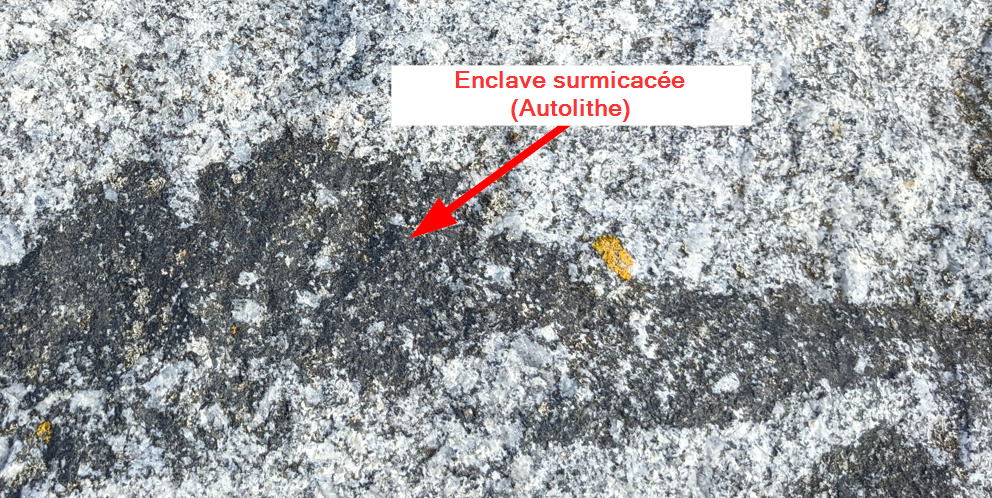
The church of Saint Martin de la Selle Craonnaise presents for its construction two local rocks allowing to make a comparative study.
► The "Roussards"
The "Roussards" are a set of sedimentary formations of detrital origin. As such, their lithological nature depends on the size of its sediments (grain size classification).
A "Roussard" rock is distinguished from other detrital formations by its ferruginous cement.
In a hot, humid climate, waters enriched with silica and iron cement the clasts into a ferruginous armor, resulting in a very hard, deep brown to rust colored matrix.
► Granite, a QFM rock
Granite is a rather clear, homogeneous, hard, unbedded crystalline formation resulting from the deep crystallization of a magma.
Its main chemical composition is 3 minerals with the initials "QFM":
- Q for Quartz: translucent sometimes transparent, this mineral is gray in color without facets.
- F for Feldspar: whitish or pink, this mineral is opaque and often twinned.
- M for Mica: black or white, this mineral comes in thin shiny strips.
The rock has a grainy texture whose grain size is directly related to the rate of crystallization: the larger the crystals, the slower the rate of crystallization.
In the extreme case, the largest crystals of feldspars exceed one centimeter in length and are called phenocrysts.
We then speak of granite with a porphyroid texture.
The granite sometimes contains enclaves called autoliths.
These autoliths have the same origin as its surrounding rock and are the result of two distinct phases in the formation of the granite due to particular conditions (very gradual drop in temperature) and an original chemical composition (high content of ferromagnesians often resulting from a migmatitis).
Ferromagnesian minerals first crystallize as biotite (black mica).
When these biotite minerals are in high concentration, they migrate in the magmatic liquid and gather in rounded surmicaceous enclaves (autolithic accumulation of biotite).
► Sources bibliographiques / Bibliographical sources
Les Questions / The Questions
Questions pour valider :"Les Roches de la Selle Craonnaise"
Questions to validate: "The Rocks of the Selle Craonnaise"
- Question 0 : Prenez une photo de vous ou d'un élément vous appartenant devant l'église.
Cette photo devra au choix nous être transmise avec les réponses ou être ajoutée à votre log.
-Question 0 : Take a picture of yourself or something belonging to you in front of the church.
This photo must either be sent to us with the answers or added to your log.
Point 1 : N 47° 50.552 W 001° 02.580
Vous voici sur le côté de l'église devant une petite porte. Observons le mur un peu en saillie sur la gauche de la porte (photo WP1).
Here you are on the side of the church in front of a small door. Let's observe the slightly projecting wall on the left of the door (photo WP1).
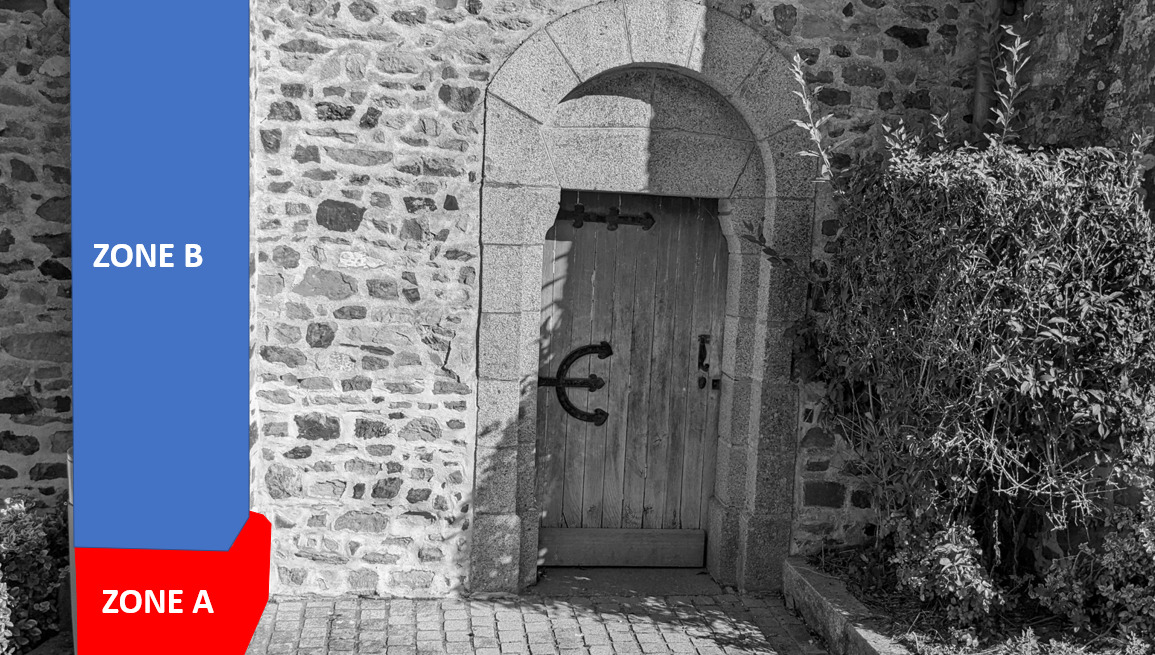
- Question 1 : Décrivez la roche sous la zone rouge A et déduisez en sa nature.
- Question 1: Describe the rock under red zone A and deduce its nature.
- Question 2 : Décrivez la roche sous la zone bleue B et déduisez en sa nature.
- Question 2: Describe the rock under blue zone B and deduce its nature.
- Question 3 : Expliquez la position relative des deux roches dans la construction.
- Question 3: Explain the relative position of the two rocks in the construction.
Point 2 : N 47° 50.559 W 001° 02.601
Vous voici sous le porche devant la porte de l'église. Observons la zone de droite (le pilier et le mur adjacent) de la photo WP2.
Here you are on the porch in front of the church door. Let's look at the area on the right (the pillar and the adjacent wall) of photo WP2.
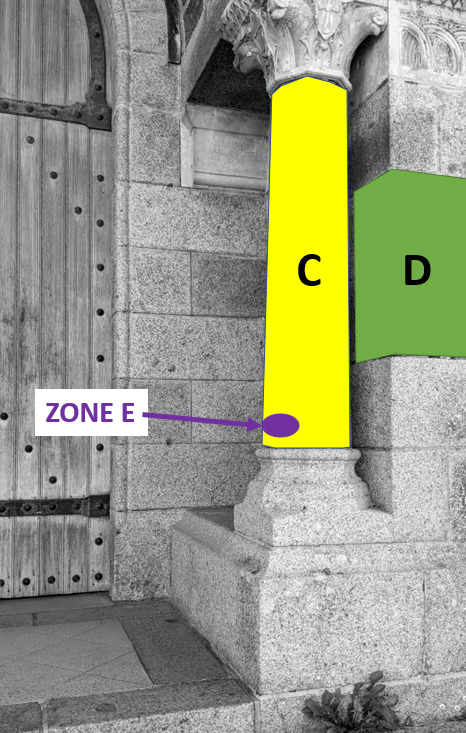
- Question 4 : Quelle principale différence observez-vous entre les deux ensembles de granites sous les zones jaunes C et vertes D ? Déduisez en leurs conditions respectives de formation.
- Question 4: What main difference do you observe between the two sets of granites under the yellow C and green D zones? Deduce in their respective conditions of formation.
- Question 5 : Sous la zone violette E se trouve une formation particulière. Décrivez là et identifiez ce type de formation.
- Question 5: Beneath the purple area E is a peculiar formation. Describe and identify this type of formation.
Vous pouvez vous loguer sans attendre notre confirmation,
mais vous devez nous envoyer les réponses en même temps soit par mail via notre profil (
fafahakkai), soit via la messagerie geocaching.com (Message Center).
S'il y a des problèmes avec vos réponses nous vous en ferons part.
Les logs enregistrés sans réponse seront supprimés.You can log this cache without waiting for our confirmation, but you must send us the answers at the same time, by e-mail via our profile (fafahakkai) or by the system of Message Center of geocaching.com.
If there is a problem with your answers we will notify you. The logs recorded without answers will be deleted.
Rappel concernant les « Earthcaches »: Il n'y a pas de conteneur à rechercher ni de logbook à renseigner. Il suffit de se rendre sur les lieux, de répondre aux questions ci-dessus et de nous renvoyer les réponses.
Reminder concerning "Earthcaches": there is neither a container to look for nor a logbook to sign. One need only go to the location, answer to the differents questions and send us the answers.